Uses of Information Technology in Businesses: POS System
VerifiedAdded on 2023/06/05
|11
|2673
|352
AI Summary
This report elaborates on the uses of information technology in the business field, specifically the point-of-sale system (POS). It discusses the advantages and disadvantages of the POS system, its competitive advantages, recommended telecommunication methods, and risks related to the POS system for businesses.
Contribute Materials
Your contribution can guide someone’s learning journey. Share your
documents today.

Running head: IT FOR BUSINESSES
It for Businesses
Name of the Student
Name of the University
Author Note
It for Businesses
Name of the Student
Name of the University
Author Note
Secure Best Marks with AI Grader
Need help grading? Try our AI Grader for instant feedback on your assignments.
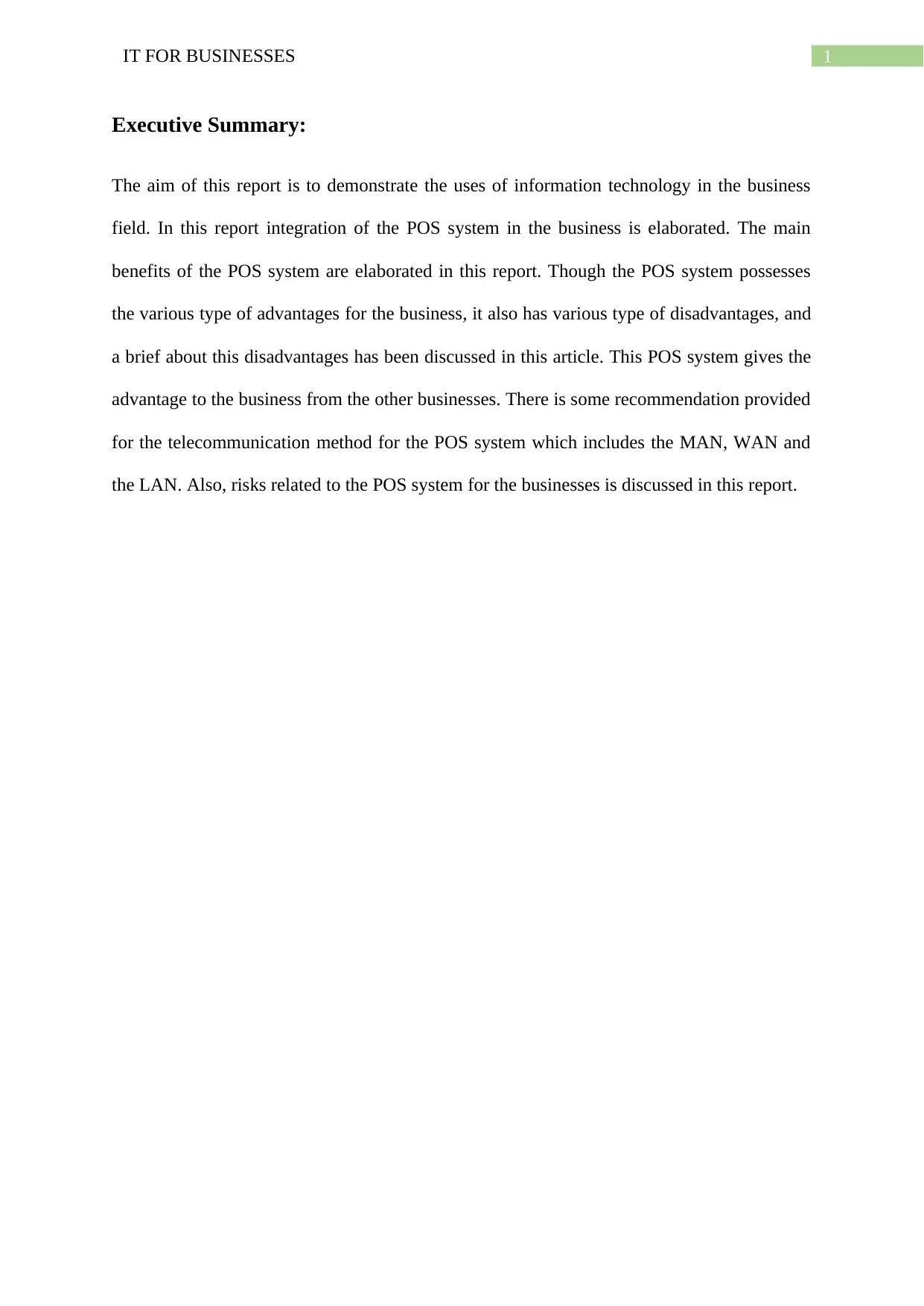
1IT FOR BUSINESSES
Executive Summary:
The aim of this report is to demonstrate the uses of information technology in the business
field. In this report integration of the POS system in the business is elaborated. The main
benefits of the POS system are elaborated in this report. Though the POS system possesses
the various type of advantages for the business, it also has various type of disadvantages, and
a brief about this disadvantages has been discussed in this article. This POS system gives the
advantage to the business from the other businesses. There is some recommendation provided
for the telecommunication method for the POS system which includes the MAN, WAN and
the LAN. Also, risks related to the POS system for the businesses is discussed in this report.
Executive Summary:
The aim of this report is to demonstrate the uses of information technology in the business
field. In this report integration of the POS system in the business is elaborated. The main
benefits of the POS system are elaborated in this report. Though the POS system possesses
the various type of advantages for the business, it also has various type of disadvantages, and
a brief about this disadvantages has been discussed in this article. This POS system gives the
advantage to the business from the other businesses. There is some recommendation provided
for the telecommunication method for the POS system which includes the MAN, WAN and
the LAN. Also, risks related to the POS system for the businesses is discussed in this report.
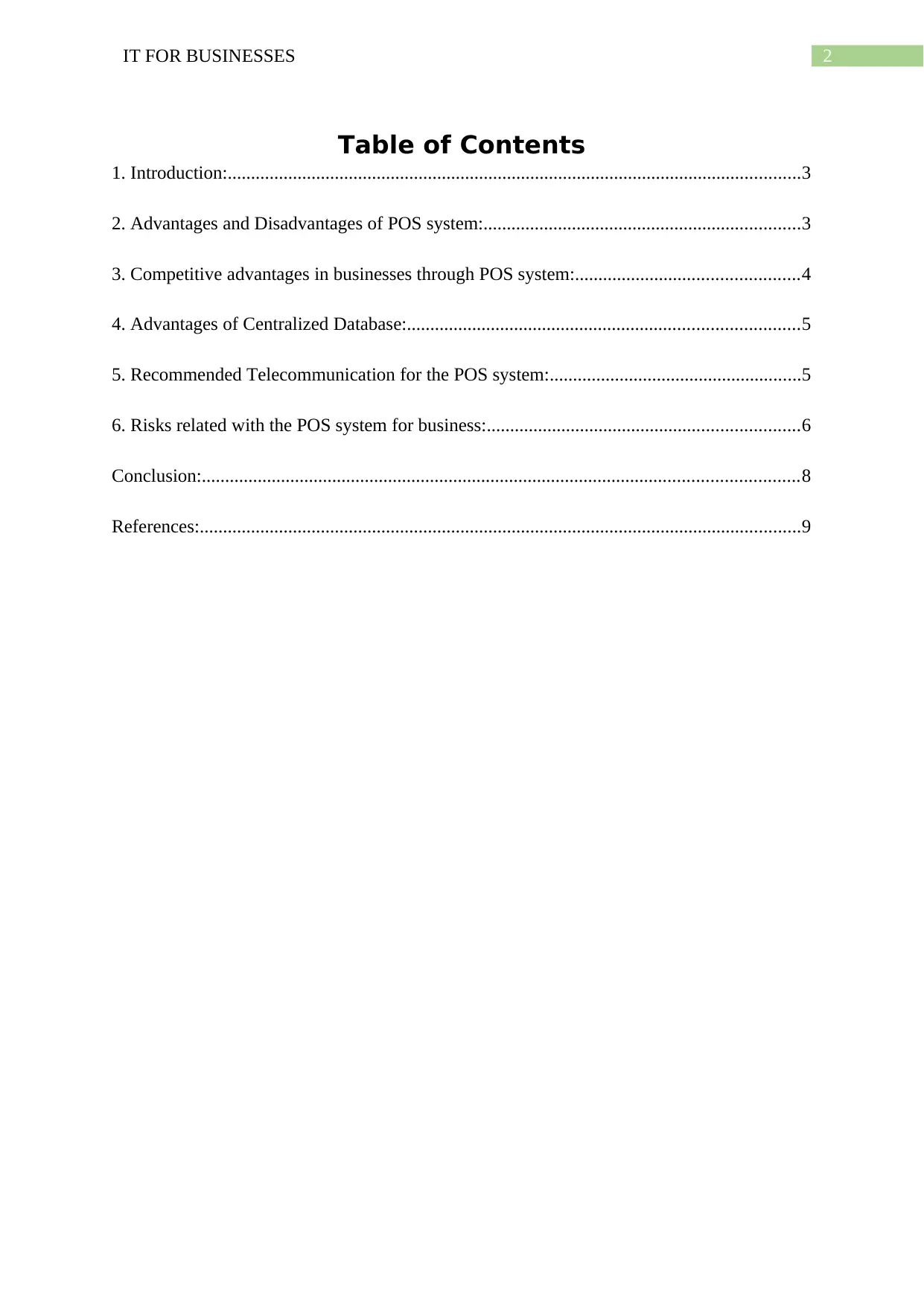
2IT FOR BUSINESSES
Table of Contents
1. Introduction:...........................................................................................................................3
2. Advantages and Disadvantages of POS system:....................................................................3
3. Competitive advantages in businesses through POS system:................................................4
4. Advantages of Centralized Database:....................................................................................5
5. Recommended Telecommunication for the POS system:......................................................5
6. Risks related with the POS system for business:...................................................................6
Conclusion:................................................................................................................................8
References:.................................................................................................................................9
Table of Contents
1. Introduction:...........................................................................................................................3
2. Advantages and Disadvantages of POS system:....................................................................3
3. Competitive advantages in businesses through POS system:................................................4
4. Advantages of Centralized Database:....................................................................................5
5. Recommended Telecommunication for the POS system:......................................................5
6. Risks related with the POS system for business:...................................................................6
Conclusion:................................................................................................................................8
References:.................................................................................................................................9

3IT FOR BUSINESSES
1. Introduction:
Information technology is leading the businesses to the path of the success by
providing new technology to the business which is actually simplifying the business process.
The information technology is providing innovation to the businesses in various way. This
innovation is resulting efficient data storing technique, faster execution of processes and
effective distribution of information in the businesses.
This article particularly focuses on a specific innovation of information technology in
the businesses which is the point-of-sale system or the POS system. A POS system simply is
a combination of hardware and software which is used for accepting the payments from the
customers for a general business transaction process (Rahman and Ripon 2014).
In this article advantages and disadvantages of POS system in business, advantages of
the centralized system and how the POS system can be used for decision making will be
evaluated. Also, some telecommunication options will be recommended for the POS system,
and the risks related to the POS system will be evaluated.
2. Advantages and Disadvantages of POS system:
The point-of-sale system or the POS system has various types of advantages in the
businesses. The main advantage of the POS system is that by using this system, the owners of
the business will be able to track the important business data extracted for the sales
transaction immediately after the sale or at the point of sale. Tracking the sales data in real
time eliminates the necessity of tracking this data manually (Scott 2016). The POS system
automatically retrieves data from a real time sale and update the stocks according to the sales
data. Also, it compiles the complete sales history.
1. Introduction:
Information technology is leading the businesses to the path of the success by
providing new technology to the business which is actually simplifying the business process.
The information technology is providing innovation to the businesses in various way. This
innovation is resulting efficient data storing technique, faster execution of processes and
effective distribution of information in the businesses.
This article particularly focuses on a specific innovation of information technology in
the businesses which is the point-of-sale system or the POS system. A POS system simply is
a combination of hardware and software which is used for accepting the payments from the
customers for a general business transaction process (Rahman and Ripon 2014).
In this article advantages and disadvantages of POS system in business, advantages of
the centralized system and how the POS system can be used for decision making will be
evaluated. Also, some telecommunication options will be recommended for the POS system,
and the risks related to the POS system will be evaluated.
2. Advantages and Disadvantages of POS system:
The point-of-sale system or the POS system has various types of advantages in the
businesses. The main advantage of the POS system is that by using this system, the owners of
the business will be able to track the important business data extracted for the sales
transaction immediately after the sale or at the point of sale. Tracking the sales data in real
time eliminates the necessity of tracking this data manually (Scott 2016). The POS system
automatically retrieves data from a real time sale and update the stocks according to the sales
data. Also, it compiles the complete sales history.
Secure Best Marks with AI Grader
Need help grading? Try our AI Grader for instant feedback on your assignments.
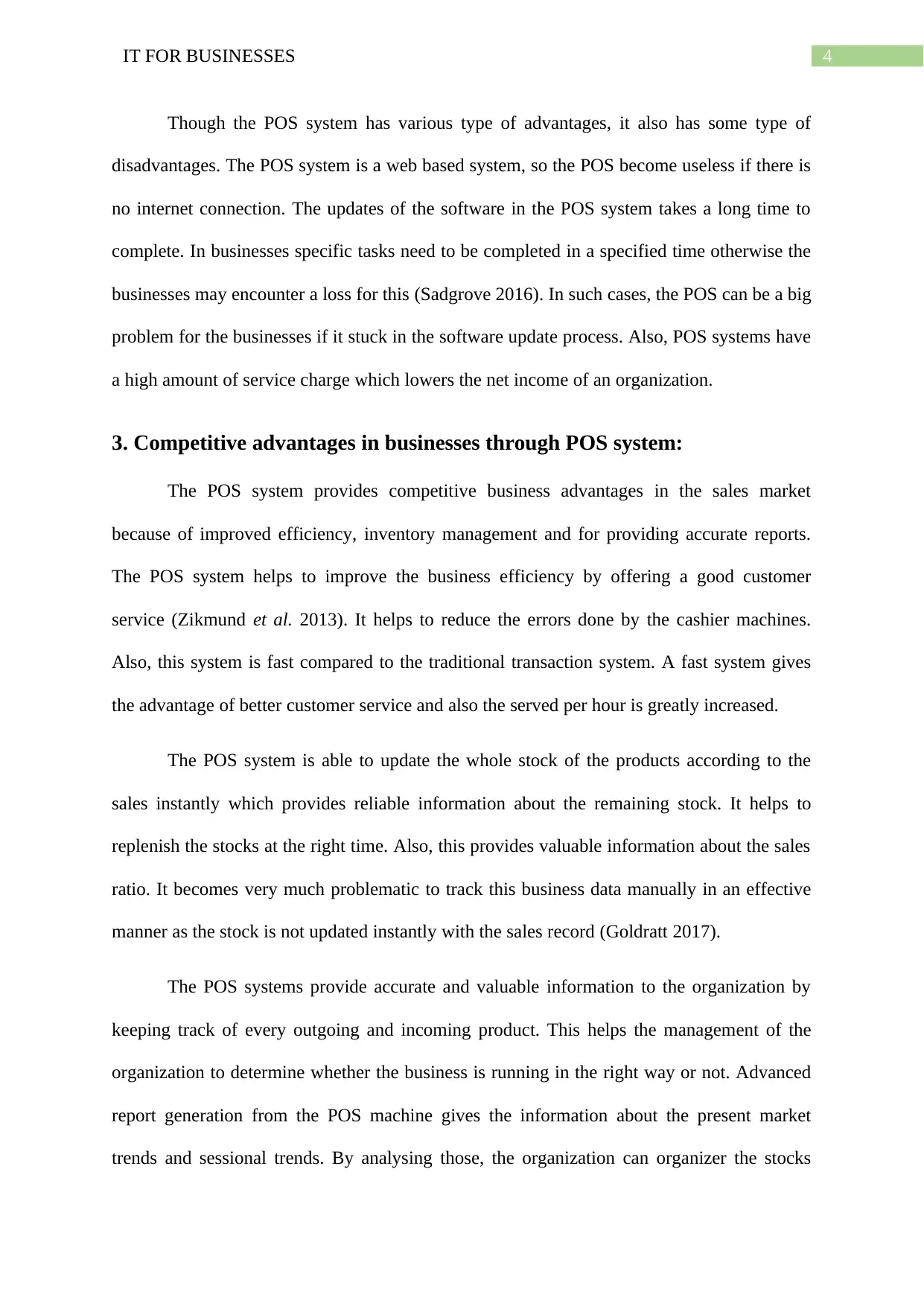
4IT FOR BUSINESSES
Though the POS system has various type of advantages, it also has some type of
disadvantages. The POS system is a web based system, so the POS become useless if there is
no internet connection. The updates of the software in the POS system takes a long time to
complete. In businesses specific tasks need to be completed in a specified time otherwise the
businesses may encounter a loss for this (Sadgrove 2016). In such cases, the POS can be a big
problem for the businesses if it stuck in the software update process. Also, POS systems have
a high amount of service charge which lowers the net income of an organization.
3. Competitive advantages in businesses through POS system:
The POS system provides competitive business advantages in the sales market
because of improved efficiency, inventory management and for providing accurate reports.
The POS system helps to improve the business efficiency by offering a good customer
service (Zikmund et al. 2013). It helps to reduce the errors done by the cashier machines.
Also, this system is fast compared to the traditional transaction system. A fast system gives
the advantage of better customer service and also the served per hour is greatly increased.
The POS system is able to update the whole stock of the products according to the
sales instantly which provides reliable information about the remaining stock. It helps to
replenish the stocks at the right time. Also, this provides valuable information about the sales
ratio. It becomes very much problematic to track this business data manually in an effective
manner as the stock is not updated instantly with the sales record (Goldratt 2017).
The POS systems provide accurate and valuable information to the organization by
keeping track of every outgoing and incoming product. This helps the management of the
organization to determine whether the business is running in the right way or not. Advanced
report generation from the POS machine gives the information about the present market
trends and sessional trends. By analysing those, the organization can organizer the stocks
Though the POS system has various type of advantages, it also has some type of
disadvantages. The POS system is a web based system, so the POS become useless if there is
no internet connection. The updates of the software in the POS system takes a long time to
complete. In businesses specific tasks need to be completed in a specified time otherwise the
businesses may encounter a loss for this (Sadgrove 2016). In such cases, the POS can be a big
problem for the businesses if it stuck in the software update process. Also, POS systems have
a high amount of service charge which lowers the net income of an organization.
3. Competitive advantages in businesses through POS system:
The POS system provides competitive business advantages in the sales market
because of improved efficiency, inventory management and for providing accurate reports.
The POS system helps to improve the business efficiency by offering a good customer
service (Zikmund et al. 2013). It helps to reduce the errors done by the cashier machines.
Also, this system is fast compared to the traditional transaction system. A fast system gives
the advantage of better customer service and also the served per hour is greatly increased.
The POS system is able to update the whole stock of the products according to the
sales instantly which provides reliable information about the remaining stock. It helps to
replenish the stocks at the right time. Also, this provides valuable information about the sales
ratio. It becomes very much problematic to track this business data manually in an effective
manner as the stock is not updated instantly with the sales record (Goldratt 2017).
The POS systems provide accurate and valuable information to the organization by
keeping track of every outgoing and incoming product. This helps the management of the
organization to determine whether the business is running in the right way or not. Advanced
report generation from the POS machine gives the information about the present market
trends and sessional trends. By analysing those, the organization can organizer the stocks

5IT FOR BUSINESSES
according to the trends which will give a huge benefit to the organization (Edwards, Magee
and Bassetti 2018).
4. Advantages of Centralized Database:
The main advantages of the centralized databases are:
The implementation of the centralized database maximize the data integrity and
minimize the data redundancy. This makes the collected data accurate and reliable
(Moniruzzaman and Hossain 2013).
This centralized database includes a fault tolerance setup which preserves the internal
data more precisely compared to another type of databases (Li and Manoharan 2013).
The centralised databases imply a single database design which is easy to handle by
an end user.
Data administration and data portability are simplified in this type of centralised
database system which is a major advantage of this type of system (Zheng et al.
2017).
In the centralized database system the cost of labour charge, maintenance cost and the
power supply costs are minimized compared to other types of databases.
As the centralised database system uses only a single database, it is easy to make the
required changes to the data, analysing the data and reorganizing the data. Also, this
gives another benefit which is that all information is accessible from a single point of
the location at the same time.
High security is implemented for the centralized database system because all the
important data is stored in a single location (Zaki 2014).
Any updated data in the centralized database system immediately goes to every
authenticated user of the database system.
according to the trends which will give a huge benefit to the organization (Edwards, Magee
and Bassetti 2018).
4. Advantages of Centralized Database:
The main advantages of the centralized databases are:
The implementation of the centralized database maximize the data integrity and
minimize the data redundancy. This makes the collected data accurate and reliable
(Moniruzzaman and Hossain 2013).
This centralized database includes a fault tolerance setup which preserves the internal
data more precisely compared to another type of databases (Li and Manoharan 2013).
The centralised databases imply a single database design which is easy to handle by
an end user.
Data administration and data portability are simplified in this type of centralised
database system which is a major advantage of this type of system (Zheng et al.
2017).
In the centralized database system the cost of labour charge, maintenance cost and the
power supply costs are minimized compared to other types of databases.
As the centralised database system uses only a single database, it is easy to make the
required changes to the data, analysing the data and reorganizing the data. Also, this
gives another benefit which is that all information is accessible from a single point of
the location at the same time.
High security is implemented for the centralized database system because all the
important data is stored in a single location (Zaki 2014).
Any updated data in the centralized database system immediately goes to every
authenticated user of the database system.
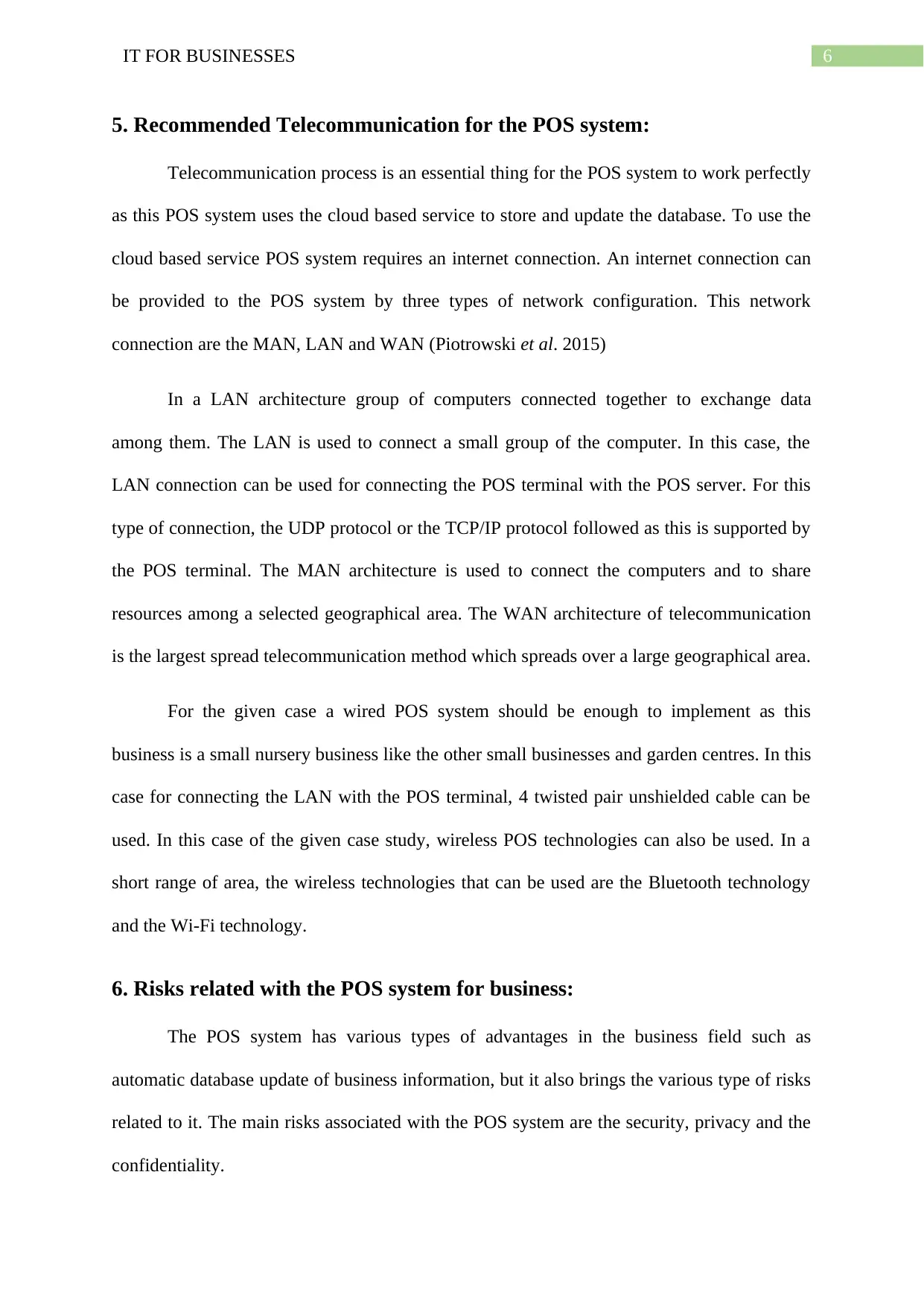
6IT FOR BUSINESSES
5. Recommended Telecommunication for the POS system:
Telecommunication process is an essential thing for the POS system to work perfectly
as this POS system uses the cloud based service to store and update the database. To use the
cloud based service POS system requires an internet connection. An internet connection can
be provided to the POS system by three types of network configuration. This network
connection are the MAN, LAN and WAN (Piotrowski et al. 2015)
In a LAN architecture group of computers connected together to exchange data
among them. The LAN is used to connect a small group of the computer. In this case, the
LAN connection can be used for connecting the POS terminal with the POS server. For this
type of connection, the UDP protocol or the TCP/IP protocol followed as this is supported by
the POS terminal. The MAN architecture is used to connect the computers and to share
resources among a selected geographical area. The WAN architecture of telecommunication
is the largest spread telecommunication method which spreads over a large geographical area.
For the given case a wired POS system should be enough to implement as this
business is a small nursery business like the other small businesses and garden centres. In this
case for connecting the LAN with the POS terminal, 4 twisted pair unshielded cable can be
used. In this case of the given case study, wireless POS technologies can also be used. In a
short range of area, the wireless technologies that can be used are the Bluetooth technology
and the Wi-Fi technology.
6. Risks related with the POS system for business:
The POS system has various types of advantages in the business field such as
automatic database update of business information, but it also brings the various type of risks
related to it. The main risks associated with the POS system are the security, privacy and the
confidentiality.
5. Recommended Telecommunication for the POS system:
Telecommunication process is an essential thing for the POS system to work perfectly
as this POS system uses the cloud based service to store and update the database. To use the
cloud based service POS system requires an internet connection. An internet connection can
be provided to the POS system by three types of network configuration. This network
connection are the MAN, LAN and WAN (Piotrowski et al. 2015)
In a LAN architecture group of computers connected together to exchange data
among them. The LAN is used to connect a small group of the computer. In this case, the
LAN connection can be used for connecting the POS terminal with the POS server. For this
type of connection, the UDP protocol or the TCP/IP protocol followed as this is supported by
the POS terminal. The MAN architecture is used to connect the computers and to share
resources among a selected geographical area. The WAN architecture of telecommunication
is the largest spread telecommunication method which spreads over a large geographical area.
For the given case a wired POS system should be enough to implement as this
business is a small nursery business like the other small businesses and garden centres. In this
case for connecting the LAN with the POS terminal, 4 twisted pair unshielded cable can be
used. In this case of the given case study, wireless POS technologies can also be used. In a
short range of area, the wireless technologies that can be used are the Bluetooth technology
and the Wi-Fi technology.
6. Risks related with the POS system for business:
The POS system has various types of advantages in the business field such as
automatic database update of business information, but it also brings the various type of risks
related to it. The main risks associated with the POS system are the security, privacy and the
confidentiality.
Paraphrase This Document
Need a fresh take? Get an instant paraphrase of this document with our AI Paraphraser
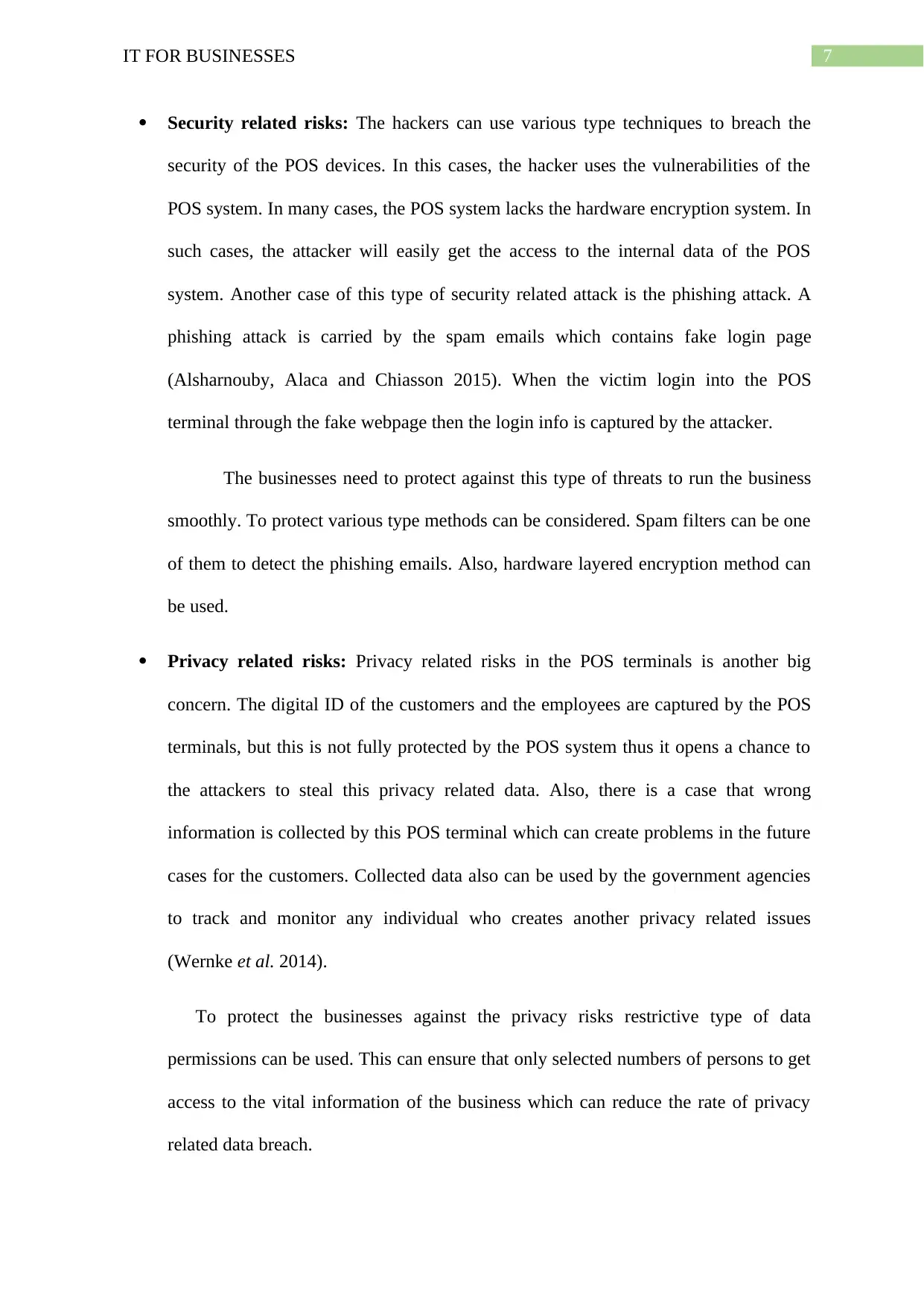
7IT FOR BUSINESSES
Security related risks: The hackers can use various type techniques to breach the
security of the POS devices. In this cases, the hacker uses the vulnerabilities of the
POS system. In many cases, the POS system lacks the hardware encryption system. In
such cases, the attacker will easily get the access to the internal data of the POS
system. Another case of this type of security related attack is the phishing attack. A
phishing attack is carried by the spam emails which contains fake login page
(Alsharnouby, Alaca and Chiasson 2015). When the victim login into the POS
terminal through the fake webpage then the login info is captured by the attacker.
The businesses need to protect against this type of threats to run the business
smoothly. To protect various type methods can be considered. Spam filters can be one
of them to detect the phishing emails. Also, hardware layered encryption method can
be used.
Privacy related risks: Privacy related risks in the POS terminals is another big
concern. The digital ID of the customers and the employees are captured by the POS
terminals, but this is not fully protected by the POS system thus it opens a chance to
the attackers to steal this privacy related data. Also, there is a case that wrong
information is collected by this POS terminal which can create problems in the future
cases for the customers. Collected data also can be used by the government agencies
to track and monitor any individual who creates another privacy related issues
(Wernke et al. 2014).
To protect the businesses against the privacy risks restrictive type of data
permissions can be used. This can ensure that only selected numbers of persons to get
access to the vital information of the business which can reduce the rate of privacy
related data breach.
Security related risks: The hackers can use various type techniques to breach the
security of the POS devices. In this cases, the hacker uses the vulnerabilities of the
POS system. In many cases, the POS system lacks the hardware encryption system. In
such cases, the attacker will easily get the access to the internal data of the POS
system. Another case of this type of security related attack is the phishing attack. A
phishing attack is carried by the spam emails which contains fake login page
(Alsharnouby, Alaca and Chiasson 2015). When the victim login into the POS
terminal through the fake webpage then the login info is captured by the attacker.
The businesses need to protect against this type of threats to run the business
smoothly. To protect various type methods can be considered. Spam filters can be one
of them to detect the phishing emails. Also, hardware layered encryption method can
be used.
Privacy related risks: Privacy related risks in the POS terminals is another big
concern. The digital ID of the customers and the employees are captured by the POS
terminals, but this is not fully protected by the POS system thus it opens a chance to
the attackers to steal this privacy related data. Also, there is a case that wrong
information is collected by this POS terminal which can create problems in the future
cases for the customers. Collected data also can be used by the government agencies
to track and monitor any individual who creates another privacy related issues
(Wernke et al. 2014).
To protect the businesses against the privacy risks restrictive type of data
permissions can be used. This can ensure that only selected numbers of persons to get
access to the vital information of the business which can reduce the rate of privacy
related data breach.
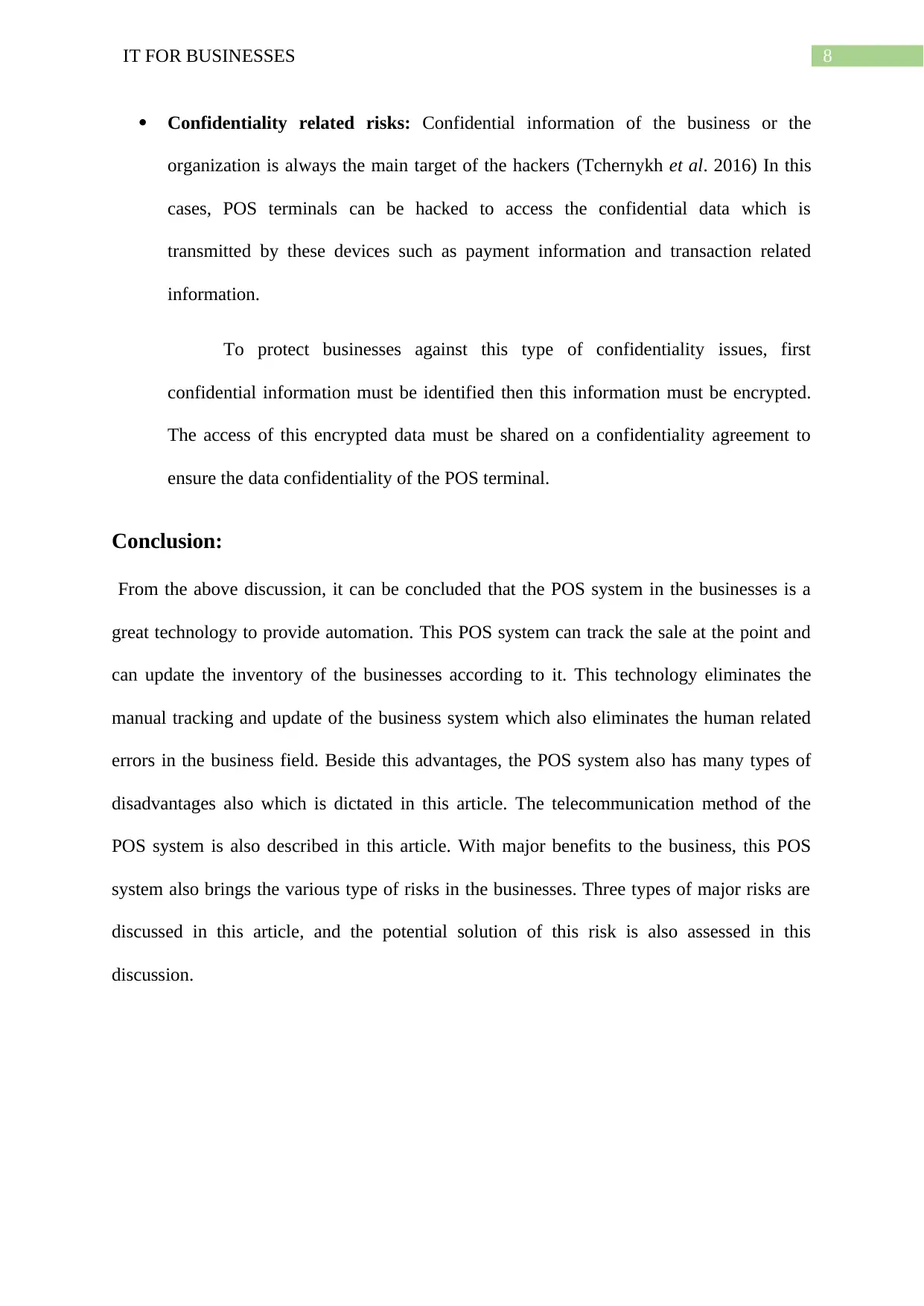
8IT FOR BUSINESSES
Confidentiality related risks: Confidential information of the business or the
organization is always the main target of the hackers (Tchernykh et al. 2016) In this
cases, POS terminals can be hacked to access the confidential data which is
transmitted by these devices such as payment information and transaction related
information.
To protect businesses against this type of confidentiality issues, first
confidential information must be identified then this information must be encrypted.
The access of this encrypted data must be shared on a confidentiality agreement to
ensure the data confidentiality of the POS terminal.
Conclusion:
From the above discussion, it can be concluded that the POS system in the businesses is a
great technology to provide automation. This POS system can track the sale at the point and
can update the inventory of the businesses according to it. This technology eliminates the
manual tracking and update of the business system which also eliminates the human related
errors in the business field. Beside this advantages, the POS system also has many types of
disadvantages also which is dictated in this article. The telecommunication method of the
POS system is also described in this article. With major benefits to the business, this POS
system also brings the various type of risks in the businesses. Three types of major risks are
discussed in this article, and the potential solution of this risk is also assessed in this
discussion.
Confidentiality related risks: Confidential information of the business or the
organization is always the main target of the hackers (Tchernykh et al. 2016) In this
cases, POS terminals can be hacked to access the confidential data which is
transmitted by these devices such as payment information and transaction related
information.
To protect businesses against this type of confidentiality issues, first
confidential information must be identified then this information must be encrypted.
The access of this encrypted data must be shared on a confidentiality agreement to
ensure the data confidentiality of the POS terminal.
Conclusion:
From the above discussion, it can be concluded that the POS system in the businesses is a
great technology to provide automation. This POS system can track the sale at the point and
can update the inventory of the businesses according to it. This technology eliminates the
manual tracking and update of the business system which also eliminates the human related
errors in the business field. Beside this advantages, the POS system also has many types of
disadvantages also which is dictated in this article. The telecommunication method of the
POS system is also described in this article. With major benefits to the business, this POS
system also brings the various type of risks in the businesses. Three types of major risks are
discussed in this article, and the potential solution of this risk is also assessed in this
discussion.
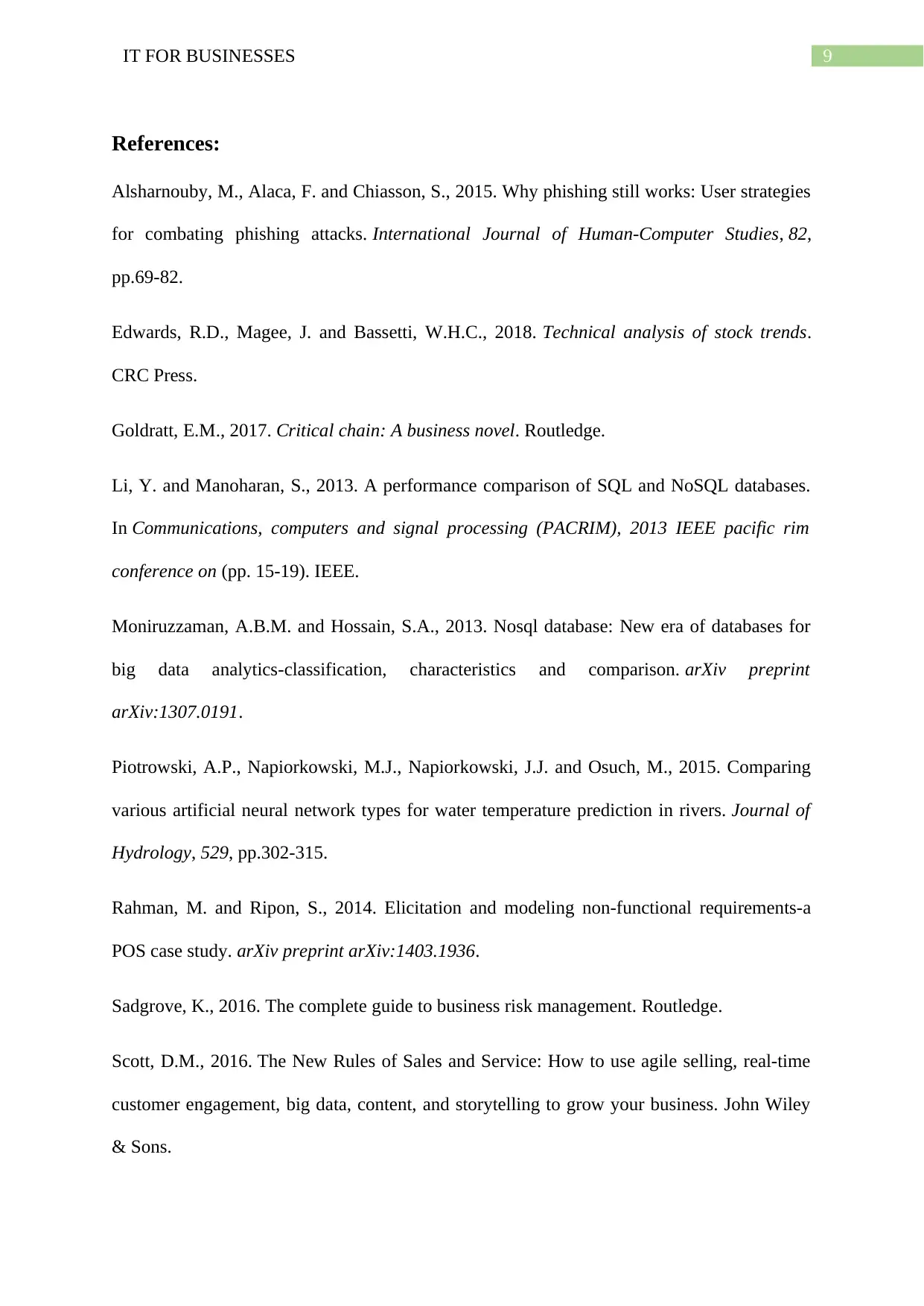
9IT FOR BUSINESSES
References:
Alsharnouby, M., Alaca, F. and Chiasson, S., 2015. Why phishing still works: User strategies
for combating phishing attacks. International Journal of Human-Computer Studies, 82,
pp.69-82.
Edwards, R.D., Magee, J. and Bassetti, W.H.C., 2018. Technical analysis of stock trends.
CRC Press.
Goldratt, E.M., 2017. Critical chain: A business novel. Routledge.
Li, Y. and Manoharan, S., 2013. A performance comparison of SQL and NoSQL databases.
In Communications, computers and signal processing (PACRIM), 2013 IEEE pacific rim
conference on (pp. 15-19). IEEE.
Moniruzzaman, A.B.M. and Hossain, S.A., 2013. Nosql database: New era of databases for
big data analytics-classification, characteristics and comparison. arXiv preprint
arXiv:1307.0191.
Piotrowski, A.P., Napiorkowski, M.J., Napiorkowski, J.J. and Osuch, M., 2015. Comparing
various artificial neural network types for water temperature prediction in rivers. Journal of
Hydrology, 529, pp.302-315.
Rahman, M. and Ripon, S., 2014. Elicitation and modeling non-functional requirements-a
POS case study. arXiv preprint arXiv:1403.1936.
Sadgrove, K., 2016. The complete guide to business risk management. Routledge.
Scott, D.M., 2016. The New Rules of Sales and Service: How to use agile selling, real-time
customer engagement, big data, content, and storytelling to grow your business. John Wiley
& Sons.
References:
Alsharnouby, M., Alaca, F. and Chiasson, S., 2015. Why phishing still works: User strategies
for combating phishing attacks. International Journal of Human-Computer Studies, 82,
pp.69-82.
Edwards, R.D., Magee, J. and Bassetti, W.H.C., 2018. Technical analysis of stock trends.
CRC Press.
Goldratt, E.M., 2017. Critical chain: A business novel. Routledge.
Li, Y. and Manoharan, S., 2013. A performance comparison of SQL and NoSQL databases.
In Communications, computers and signal processing (PACRIM), 2013 IEEE pacific rim
conference on (pp. 15-19). IEEE.
Moniruzzaman, A.B.M. and Hossain, S.A., 2013. Nosql database: New era of databases for
big data analytics-classification, characteristics and comparison. arXiv preprint
arXiv:1307.0191.
Piotrowski, A.P., Napiorkowski, M.J., Napiorkowski, J.J. and Osuch, M., 2015. Comparing
various artificial neural network types for water temperature prediction in rivers. Journal of
Hydrology, 529, pp.302-315.
Rahman, M. and Ripon, S., 2014. Elicitation and modeling non-functional requirements-a
POS case study. arXiv preprint arXiv:1403.1936.
Sadgrove, K., 2016. The complete guide to business risk management. Routledge.
Scott, D.M., 2016. The New Rules of Sales and Service: How to use agile selling, real-time
customer engagement, big data, content, and storytelling to grow your business. John Wiley
& Sons.
Secure Best Marks with AI Grader
Need help grading? Try our AI Grader for instant feedback on your assignments.
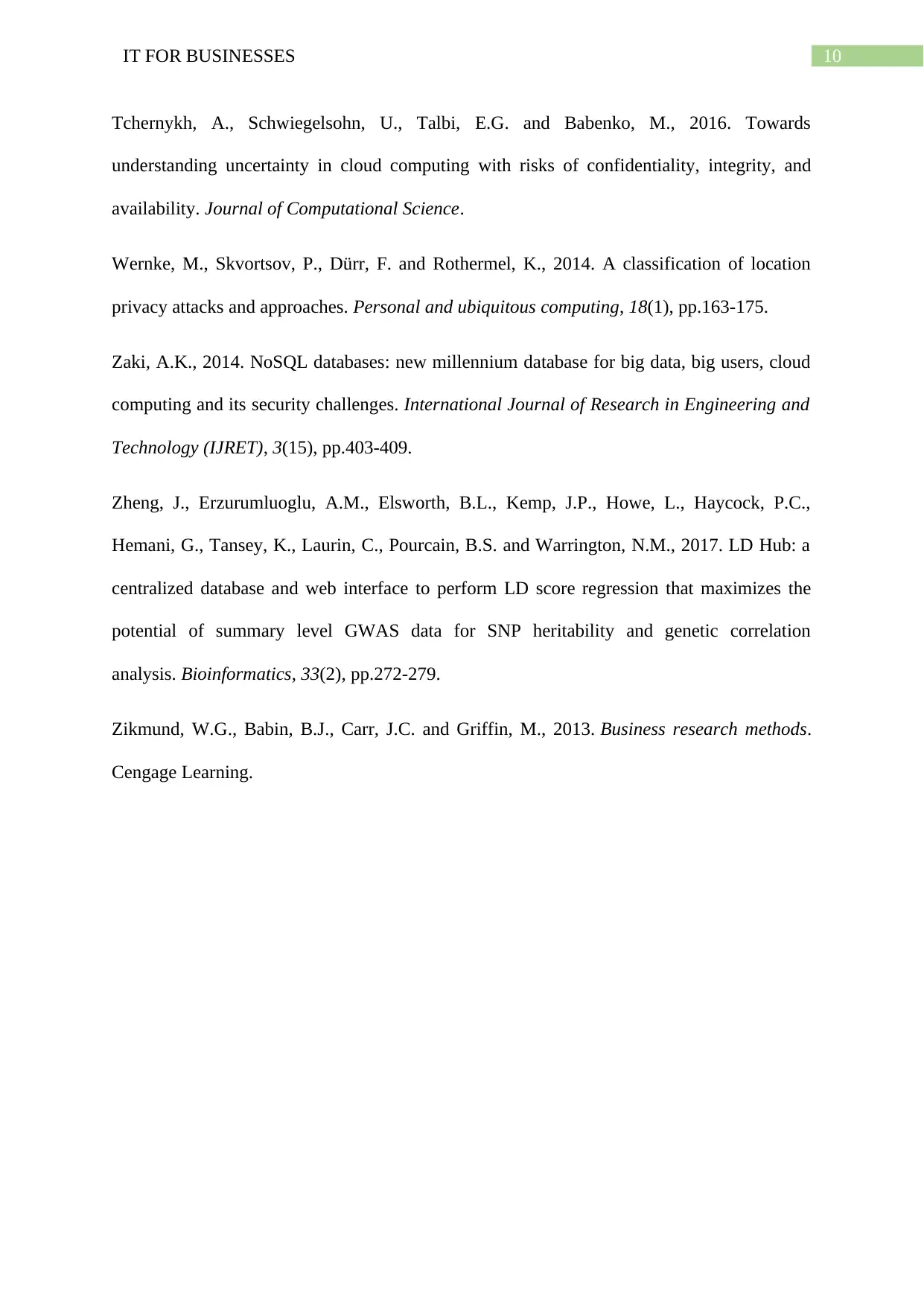
10IT FOR BUSINESSES
Tchernykh, A., Schwiegelsohn, U., Talbi, E.G. and Babenko, M., 2016. Towards
understanding uncertainty in cloud computing with risks of confidentiality, integrity, and
availability. Journal of Computational Science.
Wernke, M., Skvortsov, P., Dürr, F. and Rothermel, K., 2014. A classification of location
privacy attacks and approaches. Personal and ubiquitous computing, 18(1), pp.163-175.
Zaki, A.K., 2014. NoSQL databases: new millennium database for big data, big users, cloud
computing and its security challenges. International Journal of Research in Engineering and
Technology (IJRET), 3(15), pp.403-409.
Zheng, J., Erzurumluoglu, A.M., Elsworth, B.L., Kemp, J.P., Howe, L., Haycock, P.C.,
Hemani, G., Tansey, K., Laurin, C., Pourcain, B.S. and Warrington, N.M., 2017. LD Hub: a
centralized database and web interface to perform LD score regression that maximizes the
potential of summary level GWAS data for SNP heritability and genetic correlation
analysis. Bioinformatics, 33(2), pp.272-279.
Zikmund, W.G., Babin, B.J., Carr, J.C. and Griffin, M., 2013. Business research methods.
Cengage Learning.
Tchernykh, A., Schwiegelsohn, U., Talbi, E.G. and Babenko, M., 2016. Towards
understanding uncertainty in cloud computing with risks of confidentiality, integrity, and
availability. Journal of Computational Science.
Wernke, M., Skvortsov, P., Dürr, F. and Rothermel, K., 2014. A classification of location
privacy attacks and approaches. Personal and ubiquitous computing, 18(1), pp.163-175.
Zaki, A.K., 2014. NoSQL databases: new millennium database for big data, big users, cloud
computing and its security challenges. International Journal of Research in Engineering and
Technology (IJRET), 3(15), pp.403-409.
Zheng, J., Erzurumluoglu, A.M., Elsworth, B.L., Kemp, J.P., Howe, L., Haycock, P.C.,
Hemani, G., Tansey, K., Laurin, C., Pourcain, B.S. and Warrington, N.M., 2017. LD Hub: a
centralized database and web interface to perform LD score regression that maximizes the
potential of summary level GWAS data for SNP heritability and genetic correlation
analysis. Bioinformatics, 33(2), pp.272-279.
Zikmund, W.G., Babin, B.J., Carr, J.C. and Griffin, M., 2013. Business research methods.
Cengage Learning.
1 out of 11
![[object Object]](/_next/static/media/star-bottom.7253800d.svg)





